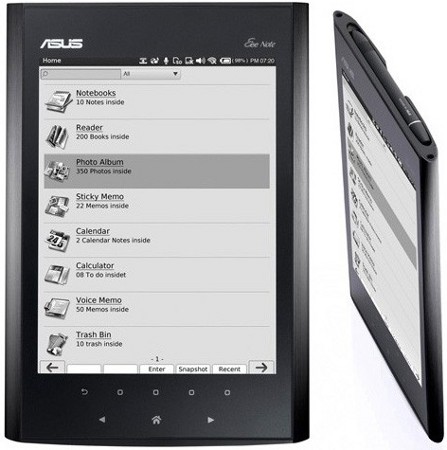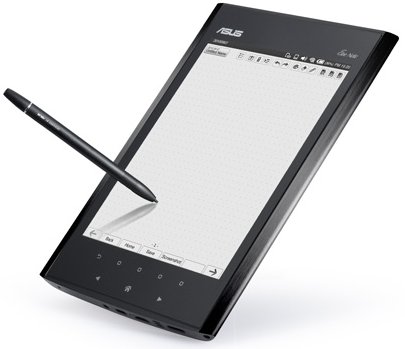Linux e-reader ships with 2450-dpi pen input
Nov 29, 2010 — by Eric Brown — from the LinuxDevices Archive — 19 viewsAsus launched its Linux-based Asus Eee Note EA800 (previously Eee Tablet) e-reader, available now in Taiwan for about $230 and due in the U.S. in 1Q 2011, according to various reports. The Eee Note has an eight-inch, 1024 x 768 monochrome display with Wacom touchscreen technology, permitting 2450 dots per inch (dpi) pen input.
Asus announced the Eee Note EA800 in June under the name Eee Tablet. In August — while announcing an Android-based Eee Pad EP101TC tablet, said to be due in March 2011 — the company revealed that the Eee Tablet might undergo a name change to Eee Note, and would start selling in October for about $300.
Asus may have missed its ship date by over a month, but the price is lower than expected, according to an IDG News story. The Eee Note will be available in Taiwan later this week for the suggested retail price of NT$6,999 ($228), says today's report.

Asus Eee Note EA800
Asus offers a web page for the device, but the associated spec sheet came up empty when we tried it. Based on details in the IDG News story, however, as well as a report from Notebook Italia posted last week, the tech details remain the same as originally announced. Some new details have also been filled in.
According to Asus, the Eee Note enables the entry of handwritten notes and sketches via pen input. The device ships with 42 templates "that cater for every note-taking need and add personalized tags for the fast finding of information," says the company.
Instead of using the E Ink VixPlex display controller typically found on e-readers — or the Sipix Imaging grayscale touchscreen used in another Asus e-reader called the Eee Reader DR-900 — the Eee Note is equipped with a monochrome screen using standard LCD technology. Measuring eight inches diagonally, it offers 1024 x 768 resolution and 64 levels of grey, says Notebook Italia.
The Eee Note is also said to include a Wacom digitizer, allowing handwritten input and providing a resolution of 2450dpi. The technology is claimed to offer accuracy of about 0.4mm with a vertical pen and about 3.0mm accuracy when the pen is tilted.

The Eee Note offers 2450-dpi Wacom pen input technology.
Other features are said to include 802.11b/g, a two-megapixel camera, and a USB port. Audio features include a microphone, speakers, and a 3.5mm audio jack. The device is said to support ePUB text files.
The main difference from the earlier, nine-inch Eee Reader DR-900, which sells in Taiwan for NT$11,988 ($391) is the difference in screen technologies, says IDG News.
"The entire cost structure of the Eee Reader is more expensive," Samson Hu, vice president and general manager of Asustek's Eee system business unit, was quoted as saying. By contrast to the Eee Reader's pricey Sipix e-paper screen, the Eee Note is said to have been made with standard PC parts, making it less expensive.
Display technology is also behind the Eee Note's shorter battery life, claimed to be 13.5 hours compared to the Eee Reader's claimed two weeks.
The Eee Note runs Linux and comes with software for reading e-books, writing notes, drawing, recording lectures, taking photos, and listening to music, says IDG News. The e-reader will be bundled with content from different local partners, depending on the market, says the story.
Availability
The Asus Eee Note EA800 will go on sale in Taiwan this week for NT$6,999 ($228), and will then appear in other markets through late 1Q 2011, says IDG News. The tablet will soon go on sale in Hong Kong, debut in China in the first quarter of 2011, and then appear later that quarter in the U.S., says the story.
The Asus Eee Note page may be found here.
The IDG News story may be found here, and the Notebook Italia story should be here.
This article was originally published on LinuxDevices.com and has been donated to the open source community by QuinStreet Inc. Please visit LinuxToday.com for up-to-date news and articles about Linux and open source.